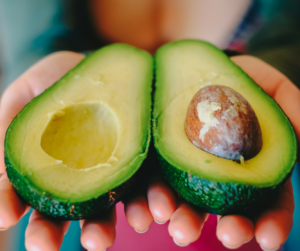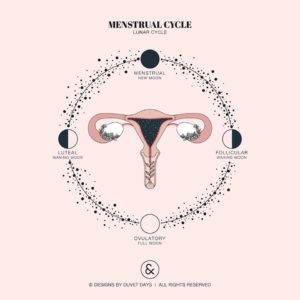 Have you seen this recent article from the Guardian on why it’s unnecessary to have a period? I saw a post responding to this article on instagram recently and immediately pulled up the article; at first glance I was annoyed and frustrated that someone could write something so misleading and as I sat with it I felt sad and disappointed for all the women who would read it and take it to heart thinking it is no big deal or of no consequence that they are on hormonal birth control thinking it will either “fix” their condition or remove the inconvenience of bleeding. Of course we all have a right to our own opinion and I am not going to point fingers and tell others they are wrong for having beliefs that differ from my own. So I thought I would share my thoughts around the discussion.
Have you seen this recent article from the Guardian on why it’s unnecessary to have a period? I saw a post responding to this article on instagram recently and immediately pulled up the article; at first glance I was annoyed and frustrated that someone could write something so misleading and as I sat with it I felt sad and disappointed for all the women who would read it and take it to heart thinking it is no big deal or of no consequence that they are on hormonal birth control thinking it will either “fix” their condition or remove the inconvenience of bleeding. Of course we all have a right to our own opinion and I am not going to point fingers and tell others they are wrong for having beliefs that differ from my own. So I thought I would share my thoughts around the discussion.
Having a menstrual cycle is normal, beautiful, and part of human life. Without it none of us would be here and it is meant to be celebrated! I won’t say I jump for joy when I start my period each month but I do appreciate that I have healthy, regular cycles after working hard to regulate my cycle and treat my own hormonal imbalances. I love seeing periods becoming normalized, talked about, breaking down the walls, and shedding (no pun intended) light on the subject.
Like many women my age I grew up thinking having a period was gross and something to be ashamed of. I hated having my period and was put on oral and hormonal contraceptive at the young age of 15 to “control” my heavy bleeding and severely painful periods. I was unaware of the challenges and imbalances it would create for me and went on and off of it for most of my 20’s. It wasn’t until I was in my early 30’s that I began to realize how much I appreciated having a normal period and learned how to use my cycle to my advantage. (By the way, if you haven’t read Woman Code by Alissa Vitti, I recommend it.) Even though I still experience heavy and painful periods I know I am doing what I can to support my body without added and synthetic hormones.
 I’d like to address a few things that came up for me as I read the article referenced above. Oral and hormonal contraceptives were introduced in the early 60’s as a way to prevent conception and control family size. In that time infertility was less common. Today, it is a whole other story. Now it is used to prevent conception, decrease unwanted menstrual symptoms and “treat” or “fix” diagnosed menstrual conditions. These menstrual conditions are serious and need to be seen as what they are, the body showing signs that need to be addressed, not covered up. These conditions often accompany severe symptoms that are debilitating for many women. These conditions show up in my office every day and often are the very things that prevent many of my patients from easily conceiving when they decide to stop taking their contraceptive after years of use. “The Pill” doesn’t fix the problem, it is only a bandaid. It also causes your ovaries to shrink, thins the lining of your uterus, and may worsen hormonal imbalance.
I’d like to address a few things that came up for me as I read the article referenced above. Oral and hormonal contraceptives were introduced in the early 60’s as a way to prevent conception and control family size. In that time infertility was less common. Today, it is a whole other story. Now it is used to prevent conception, decrease unwanted menstrual symptoms and “treat” or “fix” diagnosed menstrual conditions. These menstrual conditions are serious and need to be seen as what they are, the body showing signs that need to be addressed, not covered up. These conditions often accompany severe symptoms that are debilitating for many women. These conditions show up in my office every day and often are the very things that prevent many of my patients from easily conceiving when they decide to stop taking their contraceptive after years of use. “The Pill” doesn’t fix the problem, it is only a bandaid. It also causes your ovaries to shrink, thins the lining of your uterus, and may worsen hormonal imbalance.
When we experience discomfort during our cycles, instead of reaching for something to cover up the pain, I encourage you to consider why those symptoms are there in the first place. Here are a few examples: polycystic ovary syndrome, fibroids, ovarian cysts, endometriosis, dysfunctional uterine bleeding, amenorrhea, and premenstrual dysphoric disorder. These are just a few, but many are linked to larger health problems that should NEVER be ignored such as insulin resistance, thyroid problems, metabolic problems, cardiovascular problems, anemia, depression, anxiety, endocrine disruption, and hormonal imbalances. They each have their own complications and range from mild to severe that can be detrimental to fertility, carrying a health pregnancy, linked to cancer, and more.
So… yes it is nice to not bleed every month or experience PMS, but is the cost of convenience worth it? My answer is no. My hope is that by raising awareness around these conditions and normalizing menstrual cycles we can help future generations of women to celebrate their bodies and their cycles.

 What foods best support your fertility? Ideally, most of the foods we consume should be organic as well as pesticide and chemical free and in their whole and unprocessed form. If all organic is cost prohibitive you can focus on keeping the ‘dirty dozen’ organic, as well as 100% organic meat, eggs and full fat dairy. You can check the
What foods best support your fertility? Ideally, most of the foods we consume should be organic as well as pesticide and chemical free and in their whole and unprocessed form. If all organic is cost prohibitive you can focus on keeping the ‘dirty dozen’ organic, as well as 100% organic meat, eggs and full fat dairy. You can check the 
 In Chinese medicine, we have a very similar view; the body is in a constant dynamic of change, never static. When we adopt healthy changes we can decrease the degree the pendulum will swing in each direction and therefore decrease the negative and pesky symptoms we experience. This is why acupuncture treatments vary, because your symptoms are never the same. By treating the body as a whole and selecting points that target each phase of your cycle, the hormones will be supported. But this work does not stop when you leave the treatment room. By integrating diet and lifestyle changes, you will see great changes in the health of your menstrual cycle. This means a decrease in cramps, less bloating, optimal digestion, decrease in breast swelling, decreasing PMS symptoms like anxiety, depression, and headaches before your cycle. The changes you make encourage healthy bleeding, showing a deep vibrant red colored blood, no spotting before or after, regular cycles, and removing stagnation that leads to clots. The changes boost your energy, stopping uterine and ovarian cysts and fibroids, as well as supporting weight management. And my favorite – boosting your fertility and allowing for optimal ovulation for implantation and supporting a healthy full term pregnancy. This practice has also been proven to put certain conditions like PCOS (polycystic ovarian syndrome) and endometriosis into remission as well and a new research study shows that is can stave off early menopause by three years!
In Chinese medicine, we have a very similar view; the body is in a constant dynamic of change, never static. When we adopt healthy changes we can decrease the degree the pendulum will swing in each direction and therefore decrease the negative and pesky symptoms we experience. This is why acupuncture treatments vary, because your symptoms are never the same. By treating the body as a whole and selecting points that target each phase of your cycle, the hormones will be supported. But this work does not stop when you leave the treatment room. By integrating diet and lifestyle changes, you will see great changes in the health of your menstrual cycle. This means a decrease in cramps, less bloating, optimal digestion, decrease in breast swelling, decreasing PMS symptoms like anxiety, depression, and headaches before your cycle. The changes you make encourage healthy bleeding, showing a deep vibrant red colored blood, no spotting before or after, regular cycles, and removing stagnation that leads to clots. The changes boost your energy, stopping uterine and ovarian cysts and fibroids, as well as supporting weight management. And my favorite – boosting your fertility and allowing for optimal ovulation for implantation and supporting a healthy full term pregnancy. This practice has also been proven to put certain conditions like PCOS (polycystic ovarian syndrome) and endometriosis into remission as well and a new research study shows that is can stave off early menopause by three years! So what are the four phases and what exactly is a healthy cycle? Ideally a healthy menstrual cycle is 27 to 32 days, and menses or bleeding will last five to seven days that begins with moderate flow, not spotting, a deep rich red color that maintains a flow for three days, then begins to taper off slowly and ending by day seven. The first phase is the menses phase lasting 3 to 7 days, the second phase is the follicular phase lasting seven to 10 days, the ovulation phase lasting three to four days, then the follicular phase lasting 10 to 14 days.
So what are the four phases and what exactly is a healthy cycle? Ideally a healthy menstrual cycle is 27 to 32 days, and menses or bleeding will last five to seven days that begins with moderate flow, not spotting, a deep rich red color that maintains a flow for three days, then begins to taper off slowly and ending by day seven. The first phase is the menses phase lasting 3 to 7 days, the second phase is the follicular phase lasting seven to 10 days, the ovulation phase lasting three to four days, then the follicular phase lasting 10 to 14 days.  In the ovulation phase there is a sharp rise in follicle stimulating hormone and an increase in luteinizing hormone. The egg will release into the uterus and allows for estrogen and testosterone to rise. In Chinese medicine qi will need to transform yin into yang, or transitioning from the 1st half of the cycle to the 2nd. Here the goal is to course the qi and move blood, blood and yin are at their highest now and it is time to promote the movement of qi and blood. This is a good time to connect with your community since energy is high and communication is at its easiest. Foods to focus on are lighter grains, lots of fruits and veggies, and steamed or raw foods.
In the ovulation phase there is a sharp rise in follicle stimulating hormone and an increase in luteinizing hormone. The egg will release into the uterus and allows for estrogen and testosterone to rise. In Chinese medicine qi will need to transform yin into yang, or transitioning from the 1st half of the cycle to the 2nd. Here the goal is to course the qi and move blood, blood and yin are at their highest now and it is time to promote the movement of qi and blood. This is a good time to connect with your community since energy is high and communication is at its easiest. Foods to focus on are lighter grains, lots of fruits and veggies, and steamed or raw foods. , is one of the best female health herbs available and happens to be a Western herb, native to Greece and Italy. It is known to to regulate the menstrual cycle and reduce premenstrual symptoms, making it a popular choice for many women, but an added benefit is that for those desiring to conceive, it also boosts fertility. It has been proven to help during pregnancy when there is a history of miscarriages, and it can be helpful in stimulating milk production after birth.
, is one of the best female health herbs available and happens to be a Western herb, native to Greece and Italy. It is known to to regulate the menstrual cycle and reduce premenstrual symptoms, making it a popular choice for many women, but an added benefit is that for those desiring to conceive, it also boosts fertility. It has been proven to help during pregnancy when there is a history of miscarriages, and it can be helpful in stimulating milk production after birth.